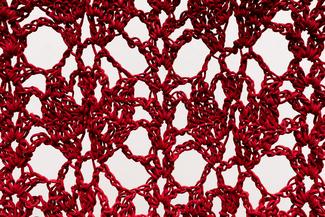
kortinas Ektor Garcia
ektor garcia is always working. Drawn to handmade, labor-intensive processes, the artist took on the practice of crocheting over two decades ago as a self-taught skill. The ability to work alone with a single hook anywhere and anytime was particularly captivating for garcia then as it is now. In this way, garcia’s time-intensive creative process has been a platform for emancipation. Long periods of time in the studio grant garcia both the permission and the privilege to be alone, temporally immune from the demands of contemporary society and immersed in meditative, almost hypnotic creative patterns.
Working primarily within textile and fiber-based art, garcia places his practice at the intersection of fine arts and craft, eschewing hierarchies often projected onto both fields. Throughout his career, garcia has crocheted with almost anything – apart from yarn – including leather, copper wire, suede, silver strings, and other metal threads. This defying, non-confirming aspect of his crocheting language has equipped the artist with an innate familiarity of materials and an ever-growing curiosity concerning the possibilities of his practice. With each material, garcia uncovers new properties that influence the work, such as the scent of leather or changing properties of copper wire, a material inherently capable of transferring energy. By allowing the work to embrace innate materiality, garcia hopes to cultivate new cultures, ones non-predicated on rigid norms.
Similarly, garcia has expanded his practice to include ceramics, welding, and metal casting. The artist describes this commitment to handmade traditions as a manifesto against a technologically-obsessed society. When crocheting, sculpting, or welding, the artist candidly admits to leaving errors and accidents in his pieces, describing the fingerprints of life and soul that rubbed-off onto garcia’s works.
kortinas, at Mendes Wood DM, São Paulo is the artist’s first solo exhibition in Brazil. Drawn to the theatricality of curtains, garcia contemplates the realities that might be hidden, shadowed, or protected behind them in people’s homes. Working around this imagined semiology, the artist has created a large, windowless space filled with his styled curtains. Curtains that are deceiving, that look familiar like fabric or crochet-curtains, but that, on inspection, reveal new materials, light, effects, scents. Curtains that both hide and reveal.
For the occasion of kortinas, the artist has also experimented with a new textile material, a synthetic reflective fabric used for signage and safety applications. Usually adorning the uniforms of commuting cyclists, construction workers, and others seeking to enhance visibility, in garcia’s hands they become large textile installations that emulate and reflect “curtain call” lighting. Throughout the exhibition, sets of curtains stand on their own on metal stands welded by the artist while others hang independently from the ceiling, crawl onto the walls, or spread out over the floors, influenced by both the architecture and the environment of the space. On view, a selection of ceramic sculptures created in Brazil adds new layers to the exhibition’s central themes, continuing garcia’s dramaturgy between intimate dialogue and materiality.
ektor garcia (b. 1985, Red Bluff, USA) lives and works nomadically.
garcia’s multi-faceted practice incorporates handcrafted and technically rendered objects that are often combined into multi-part installations. garcia frequently repurposes elements from his own oeuvre to create new iterations of works.
He received his BFA from the School of the Art Institute of Chicago in 2014 and his MFA from Columbia University in 2016.
He has had solo exhibitions at James Fuentes, New York (2023); Rebecca Camacho Presents, San Francisco (2022); Cabaret Voltaire, Zurich (2022); the Henry Art Gallery, University of Washington, Seattle (2022); Empty Gallery, Hong Kong (2021); and SculptureCenter, New York (2019); amongst others.
His work has been included in group exhibitions at Bibeau Krueger, New York (2024); Adams and Ollman, Portland (2024); Whitney Biennial, the Whitney Museum of American Art, New York (2024); the Blaffer Art Museum at the University of Houston (2023); Lisson Gallery, New York (2023); San Francisco Museum of Modern Art, San Francisco (2022); Cooper Cole, Toronto (2022); and the Griffith University Art Museum, Brisbane (2022).
He was artist-in-residence at the Henry Art Gallery, University of Washington, Seattle (2022) and Hammer Museum, Los Angeles (2021).